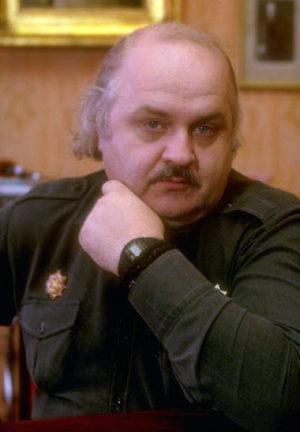Horrid News From Russia
THE Daily Telegraph (London) maintains in Russia a reporter with the odd name of Xan Smiley, who contributes a column entitled “Inside Russia,” and also signed despatches printed elsewhere in the paper. Xan is acutely worried because he discovered something horrible in Russia, and he has written about it more than once. The substance of his reports was in his column on 18 January 1988, since which he has more or less repeated himself.
There is, he says, a terrible organization that, unbelievably, is actually tolerated by the present government of the Soviet, and he claims to have bearded in his den and to have interviewed the monster who heads it, and who, incredibly, circulated privately to a chosen few a memorandum that attacked one of Gorbachev’s closest supporters in the Politburo, and yet was not liquidated! The monster is a middle-aged Russian named Dmitri Vasilyev (pictured); his organization, which claims to have a membership of 20,000 with chapters in thirty cities, is called Pamyat (“Remembrance”); its symbol is a bell, which, as Xan failed to remark, is a specifically Christian symbol. (1) Vasilyev says, however, that since his organization is nationalistic, some members are “patriotic atheists.”
(1. It is so regarded in the Near and Middle East, where church bells excite hatred in orthodox Muslims and other non-Christian sects. They are right historically. Although tintinabula, small bells that give a tinkling or jingling sound, like modern sleigh-bells and the grelots lascifs worn by bayadères and other Oriental dancing girls, are found in the early stages of so many cultures that their invention must be attributed to some prehistoric people, it seems that Christians may legitimately claim to have invented large bells with musical tones, such as were heard in every city, town, and hamlet of the United States before modernized clergymen began to tear down the edifices of stone and brick and replace them with wooden sheds, suitable for night clubs or large garages. (I must not digress to discuss the claim of priority for the Chinese; there is no reliable evidence that they cast bells of any size before the Fifteenth Century, which is the probable date intended in the romantic tale that was beautifully retold as “The Soul of the Great Bell” by Lafcadio Hearn in Some Chinese Ghosts.)
The tradition that bells were invented in the Fifth Century by Paulinus, Bishop of Nola, is undoubtedly a myth suggested by the fact that nola is a Latin term for a small bell, such as was put around the neck of a vicious dog; several nolae, mounted on a frame, were shaken in early Christian choirs (in imitation of the sistra used in the worship of Isis). The Christians seem to have begun casting bells in the Seventh Century; these were comparatively small and rectangular in shape, like the cheap cow-bells now in use, and gave only a loud clanking sound. The first certain historical use of church bells rung from steeples was in the Sicilian Vespers, the famous massacre in 1282. Really musical bells of campanulate form may not antedate the Sixteenth Century.
Church bells may have a special significance for Russians, since the largest bell in the world, weighing about 190 tons, was cast in Moscow in 1734, but broken before it was used, according to the account that is generally accepted — not the one told to tourists who go to see it today. The largest bell in the world that can actually ring, weighing 128 tons, is also in Moscow, where it was cast around the middle of the Eighteenth Century.
A charming collection of information and stories about bells, accompanied by many illustrations, may be found in Bernadine Bailey’s popular little book, Bells, bells, bells (New York; Dodd, Mead, 1978).
[It is a little-known fact that Dr. and Mrs. Oliver were close friends of Bernadine Bailey and carried on an extensive correspondence on artistic, literary, and political matters with her for decades. — K. A. S.])
Xan is horrified by Pamyat and uses the techniques of defamation that are the stock-in-trade of journalistic hacks. Vasilyev has a “beer belly” and a “toothbrush moustache”; some of his young men wear black shirts and leather jackets; he is the “guru” of a “cult of hate,” etc.
The horrible hate is obvious, because although Xan admits that Vasilyev never directly attacks Jews, only “Zionists” (as is, of course, proper in Soviet propaganda), what he says by innuendo makes it clear that he doesn’t love Yahweh’s Yids with all his heart.
Vasilyev says that a “Trojan horse” inside Soviet society, which forms only 0.69% of the population, provides 20% of the managers and 44% of the persons who hold masters’ and doctoral degrees from the universities. To a mind such as Xan’s, this is probably proof that Jews are persecuted in Russia, since, if they were not, they would form 90% of the managers and 99.9% of the holders of advanced degrees. Vasilyev perversely does not agree.
Vasilyev points out that about a hundred of the deputy heads of Stalin’s key departments were not Russians; that “not a single Russian ran the labor camps or administered the building of the White Sea-Baltic Canal” (in which as many as a million Russian slaves, taken from the best and most civilized part of the population, may have been literally worked to death), and that Czar Nicholas II was “ritually sacrificed.” Since everyone knows to what race the non-Russians belonged, this proves that Vasilyev is so full of hate that he doesn’t even want Jews to have fun.
Pamyat remembers the great achievements of Russia under the Czars, especially the battles in which the Russians repelled hordes of invading Tatars or fought valiantly against the Mongols. Vasilyev displays in his apartment portraits of Nicholas II, the last Czar, and of his only son, the young Czarevich, who perished when all members of the Imperial family were atrociously murdered in 1918 by Bolsheviks commanded by a Jew and at the orders of Bronstein (“Trotsky”); more significantly, he also has in a place of honor a portrait of Peter Stolypin, who, historians agree, was the “last truly effective and important [prime] minister of imperial Russia” (2), until he was murdered by a traitor in the police force in 1911. He effectively repressed the terrorists, mostly Jews and hybrids, who, using the methods now employed by the Jews’ Mossad, were murdering loyal Russians at the rate of 3000 a year when Stolypin became Prime Minister in 1907. He also promoted an agrarian reform designed to create in Russia a class of independent farmers and farm families, such as were the backbone of the United States before the international usurers appointed Franklin Roosevelt to begin the liquidation of the country that then was ours.
(2. My quotation comes from Nicholas Riasanovsky’s History of Russia (Oxford Press, 1963), p. 458.)
Xan is perturbed that there should be anything so “nasty” as Russians who don’t adore Kikes and he tries to account for that terrible phenomenon. His most serious suggestion is that Pamyat is promoted and protected by Igor Ligachev, a ranking and powerful member of the Politburo, who is said to disapprove of Gorbachev and to be an enemy of Yakovlev, Gorbachev’s mentor and chief propagandist. It was Yakovlev that Vasilyev and six other officers of Pamyat attacked as “cosmopolitan” and “anti-Russian” in their ten-page memorandum privately circulated to all members of the Politburo in December 1987. The “nasty” Pamyat is therefore the instrument of an opposition that wishes to overthrow Gorbachev.
That is quite possible. When Ronnie and his Russian partner were dancing the Bunny Hug, everyone knew that the ball would soon be over. Reagan will be retired from the cast of the great American burlesque show in January 1989, when he will certainly be replaced by either another shabbat goy or a person of dubious antecedents, the lackey of a Jewess. Gorbachev’s future was less predictable. At any time, whenever he has served his purpose, which may have been to make propaganda to facilitate the planned amalgamation of the United States with the Soviet Union or to cover some really secret operation, he can be thrust back into the obscurity from which he came.
If Xan’s guess is right, and if Pamyat is more than an instrument cynically used by the “conservative” and supposedly “nationalist” faction in the Politburo, then this is the first real evidence of a serious evaluation of Jews in Russia.
Xan also suggests that Pamyat has not been condignly liquidated in blood because it is a promotion of the Soviet secret police (KGB), who, as he does not remark, are, so far as anyone knows, still predominantly Jews. That also is possible. An organization appealing to Russian historical pride and patriotism would be a perfect device for luring into the open Russians who are still capable of thinking for themselves. Thus identified, they could then be inconspicuously murdered at leisure.
There is, however, the alternative possibility that Pamyat was created and exhibited to Western journalists to induce once again in credulous Aryan “racists” a soothing hope that the Russians will soon liberate themselves from their Yiddish masters.
Xan’s reported discovery must be taken into account when we try to estimate the chances that Russians may possibly recover possession of their country. But while you are pondering that problem, remember that several years ago the Observer (London), said to have the second or third largest Sunday circulation in Britain, solemnly assured English boobs, on the faith of its reporter in Washington, that all the Sweet Sheenies in the United States were trembling with fear lest the awful Robert White, publisher of the “Duck Books,” start stuffing them by the millions into gas chambers.
Mr. White, who was recently murdered in Central America, presumably by robbers, (3) never once even breathed an unkind hint about Yahweh’s masterpieces, but he did publish the “Duck Books” before giving them up, and he did denounce the plundering of the United States by greedy financiers and the predatory politicians they hire — and all Jews know that anyone who champions the American people is their enemy, whether he knows it or not. But just the same, I will bet that the Observer’s talented reporter never saw a single shivering Sheeny. He was just an up-to-date journalist. Is consternated Xan another?
(8. Some suspect that the murder was a successful operation by our bungling C.I.A., but after White gave up his promotion of the “Duck Books” and the loose organization based on them, he cannot conceivably have represented even a remotely potential menace to our enemies, and it seems unlikely they would take the trouble to plan and finance an assassination which was not even made a warning to other dissatisified Americans.)
* * *
Source: Liberty Bell magazine, November 1988







Am starting to think everything I thought I knew was wrong and the so called bad guys were not.
Greetings Robert. Yes, we’ve all had the same epiphany. Continue your adventure. Research, research, research, contribute. It is an antidote that will reward you.